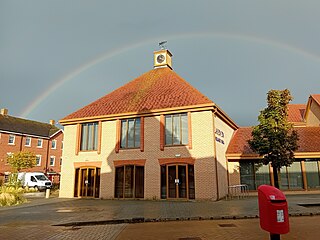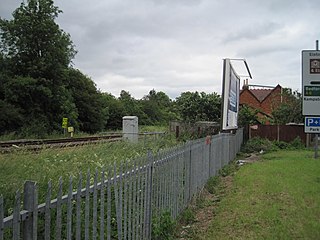Related Research Articles

Royal Ordnance Factory (ROF) Bridgwater was a factory between the villages of Puriton and Woolavington in the Sedgemoor district of Somerset, England that produced high explosives for munitions. It was slightly above sea level, between the 5-and-10-metre contour lines on Ordnance Survey maps. BAE Systems closed it when decommissioning was completed in July 2008.

The Borough of Bedford is a unitary authority area with borough status in the ceremonial county of Bedfordshire, England. Its council is based in Bedford, its namesake and principal settlement, which is the county town of Bedfordshire. The Bedford built-up-area is the 71st largest in the United Kingdom and comprises the boundaries of the pre-1974 Bedford Municipal Borough, the town of Kempston and the village of Biddenham, with the BUA surrounded by a rural area with many villages. 75% of the borough's population live in the Bedford Urban Area and the five large villages which surround it, which makes up slightly less than 6% of the total land area of the Borough.
ROF Glascoed was built as a UK government-owned, Royal Ordnance Factory (ROF). It was designed as one of 20 munitions filling factories. It was planned as a permanent ROF with the intention that, unlike some other similar facilities, it would remain open for production after the end of World War II. After privatisation of the Royal Ordnance Factories in the 1980s it became part of Royal Ordnance plc and later a production unit of BAE Systems.
ROF Bridgend,, located in Bridgend, South Wales, was one of the largest of sixteen World War II, UK government-owned, Royal Ordnance Factory munitions Filling Factories. Of great significance to the Britain's war effort, at its peak of production it employed around 40,000 people — said to be the largest ever factory in Britain's history.

The Ministry of Supply (MoS) was a department of the UK government formed on 1 August 1939 by the Ministry of Supply Act 1939 to co-ordinate the supply of equipment to all three British armed forces, headed by the Minister of Supply. A separate ministry, however, was responsible for aircraft production, and the Admiralty retained responsibilities for supplying the Royal Navy. During the war years the MoS was based at Shell Mex House in The Strand, London.
An explosive ROF was a UK government-owned Royal Ordnance Factory (ROF), which specialised in manufacturing explosives during and after World War II. In World War I, the name used in the UK for government-owned explosives factories was National Explosives Factory; the cordite factory at Gretna was known as HM Factory, Gretna.

Royal Ordnance Factories (ROFs) were munitions factories run by the UK government during and after the Second World War. The three main types of factories were engineering, filling and explosives, and these were dispersed across the country for security reasons. ROFs were the responsibility of the Ministry of Supply and later the Ministry of Defence until privatisation in 1987.
ROF Thorp Arch was one of sixteen Second World War, UK government-owned Royal Ordnance Factory, which produced munitions by "filling" them. It was a medium-sized filling factory.
A filling factory was a manufacturing plant that specialised in filling various munitions, such as bombs, shells, cartridges, pyrotechnics, and screening smokes. In the United Kingdom, during both world wars of the 20th century, the majority of the employees were women.

The Royal Ordnance Factory (ROF) Bishopton was a WW2 Ministry of Supply Explosive Factory. It is sited adjacent to the village of Bishopton in Renfrewshire, Scotland. The factory was built to manufacture the propellant cordite for the British Army and the Royal Air Force. It also later produced cordite for the Royal Navy. The Ministry of Works were responsible for the site. It was the biggest munitions factory the MOD had, with up to 20,000 workers.
RAF Credenhill, also known as RAF Hereford, was a non-flying station of the Royal Air Force situated in the village of Credenhill near Hereford, England, United Kingdom. It was commissioned in 1940 and served as home for a range of training schools from 1940 until closure in 1994. The site was subsequently obtained by the British Army.

ROF Chorley was a UK government-owned munitions filling Royal Ordnance Factory. It was planned as a permanent Royal Ordnance Factory with the intention that it, unlike some other similar facilities, would remain open for production after the end of World War II; and, together with ROF Bridgend, would replace the Royal Filling Factory located at the Royal Arsenal, Woolwich. It was built largely in Euxton, but was known as ROF Chorley.

Elstow is a village and civil parish in the Borough of Bedford, Bedfordshire, England, about 2 miles (3.2 km) south of Bedford town centre.

Wixams is a new town and civil parish located in Bedfordshire, England, which has been under construction since early 2007. It is expected to become the third largest settlement in the Borough of Bedford after Bedford itself and Kempston, and one of the largest new settlements founded in England since the British new towns movement of the first twenty five years after World War II.
ROF Kirkby, was a large World War II Royal Ordnance Factory (ROF) filling munitions. The factory was based in the rural area of Kirkby, on the outskirts of Liverpool, Merseyside. The rural location was to reduce the potential damage from any accidental explosions. Munitions were produced from September 1940 to March 1946.

Kempston & Elstow Halt was a railway station on the Varsity Line which served the Bedfordshire town of Kempston in England. Opened in 1905, it was closed temporarily during both world wars and did not reopen after 1941, being officially closed in 1949.
Ruddington Ordnance & Supply Depot was a Royal Ordnance Factory filling and storage facility, commissioned in 1940 and built during World War II by the United Kingdom Ministry of Defence (MoD). It was located to the south of Ruddington, Nottinghamshire, and took 18 months to build. In operation it consisted of over 200 buildings employing 4,000 workers at peak. It was decommissioned in 1945, became a storage area for ex-military vehicles which were then auctioned-off onsite, and was closed in 1985. Today the site is located in the Rushcliffe Country Park.

ROF Swynnerton was a Royal Ordnance Factory, more specifically a filling factory, located south of the village of Swynnerton in Staffordshire, United Kingdom. Built between 1939 and 1941, it remained operational until 1958. It is now operated by the Defence Training Estate, as Swynnerton Training Camp.
ROF Rotherwas was a Royal Ordnance Factory filling factory, No 4, located in Rotherwas, Dinedor Parish, Herefordshire, England.
National Filling Factory, Banbury, officially called National Filling Factory No. 9. was a British Ministry of Munitions filling factory, constructed during World War I and located in Banbury, Oxfordshire. The production of filled shells began in April 1916 and ended when the factory closed in 1924
References
- ↑ Private and Untimetabled Railway stations by G. Croughton page 141